
The British invaded Bayou Bienvenue in the fall, but the fish invade it in the spring.
If you’ve ever watched a parade, you probably noticed that as a marching band approaches, you hear the bass drums first and the highest-pitched instruments last. This happens because low-frequency sound carries better and farther than high-frequency sound.High-frequency sounds, on the other hand, can be repeated at a faster rate. Imagine trying to play a quick, complicated melody on a bass drum. The same is true of sound traveling through water, so these principles also apply to sonar.
Since high-frequency sound doesn’t carry as well, it must be driven with more power than low-frequency sound to reach the same depth. In fact, it isn’t practical to drive high frequencies to depths that low-frequency signals can reach with ease, so sounders designed for deep water use have lower operating frequencies than shallow water units. Sounder frequencies commonly range from about 50 kHz to 455 kHz, although some serious deep-water sounders operate at frequencies down in the teens.
Low-frequency sounders generally transmit sound pulses of longer duration, which limits their ability to separately display targets that are close together, like fish close to a wreck, near the bottom or stacked vertically in schools. Low-frequency transducers tend to have wider cone angles (30-60 degrees) than high-frequency models. A wider cone sees a larger area than a narrow cone and helps you find structure like wrecks or brushpiles faster. It’s like searching for something in the dark with a floodlight instead of a spotlight.
On the down side, fish finders scan a three-dimensional cone under the boat, and must show everything in it on a two-dimensional display. The wider the scanned area the more objects they must cram onto the screen. The more cluttered the display the more difficult it is to spot individual fish or small structure details. Finally, the wider the cone the farther a fish can be from your boat and still show up on your screen.
High-frequency units offer superior target separation, bottom detail and target location at the depths they can reach, thanks to their shorter pulse lengths and skinnier transducer cone angles.
The industry has settled on 200 kHz as a good compromise for single frequency, all purpose use. The resolution of a good 200 kHz unit is almost impossible to tell from that of a 455 kHz unit under real-world conditions. Manufacturers give saltwater 200 kHz models about 500 watts RMS of transmitter power, add transducers with extra narrow cone angles to concentrate sound and advertise depth capabilities of from 600 to 1,000 feet.
If your fishing requires top sonar performance below about 300 feet, consider a dual frequency unit with both high- and low-frequency capability. The industry low-frequency standard for these units is 50 kHz.
I’d look at a dual frequency unit for fishing deeper than 150 feet, but I like to see the dirt in the water and most fishermen can get by with less detail. In my experience, a 200 kHz unit advertised to reach a maximum depth of 800 feet will deliver good screen detail down to about half of that depth, less in water conditions that challenge sonar performance. Beyond that, under anything less than perfect conditions, you get a bottom reading and echoes from only the largest objects.
A dual-frequency unit gives you the best of both worlds. You get the narrow cone angle and great resolution of high frequency, and the superior depth penetration of low frequency when you need it. Most units can broadcast both frequencies simultaneously and display the readings side by side on a split screen.
This can be a big help when fishing a small target like a wreck or a school of suspended fish.
The low-frequency, wide cone angle will find the target faster and display it on its side of the screen. Steer the boat in an expanding spiral, and the target will quickly be spotted by the high frequency side’s narrow beam. Now, we can examine it in greater detail with our high-frequency “spotlight.” Seeing a fish on both the high and low frequency sides of the display also means that it should be right under the boat, where we can drop a lure in front of it.


